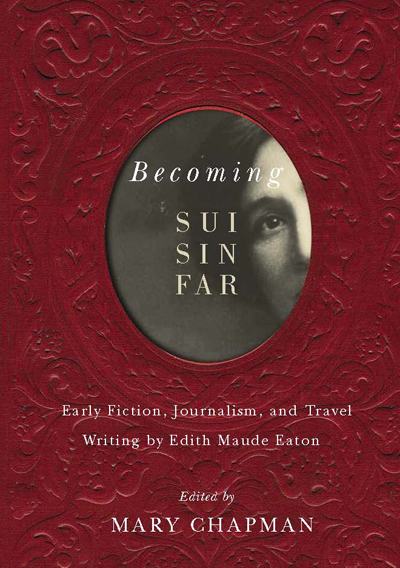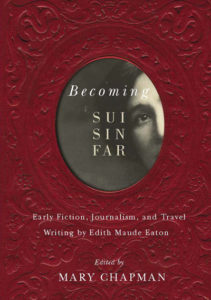From Necessity to Nuance: How Edith Maude Eaton Became Sui Sin Far, a Case Study

If one were to seek the origins of Asian diasporic literatures in North America, the name that emerges is Sui Sin Far, the pseudonym of Edith Maude Eaton, a mixed-race writer of Chinese descent from the turn of the century. Now acclaimed as the “mother” of Asian North American literature, Sui Sin Far’s place in both canon and scholarship has, in what Sau-ling Cynthia Wong has famously called Asian American literary studies’ fundamental contrasting modes, ascended from necessity to extravagance. Her name first emerged as a historical aside in the foundational 1974 Asian American writers anthology Aiiieeeee! In 1981, she was introduced to an academic audience through S.E. Solberg’s MELUS piece. “She was not a great writer,” states Solberg, “she has only one book (a collection of her stories) to her credit, but her attempts deserve recognition.” Amy Ling and Annette White-Parks’s landmark 1995 Mrs. Spring Fragrance and Other Writings heralded a major push for Sui Sin Far scholarship to go beyond the “necessity” of recovery and toward “extravagant” complexity. From initial recognition of her “attempts” at representation during the era of anti-Chinese sentiment have come sophisticated analyses of her engagement with cultural and racial hybridity, tricksterism, transnationalism, queerness, and disability, among other issues. Hsuan Hsu’s 2011 edition of Mrs. Spring Fragrance, which reprinted her book in its entirety, continues this development: he places Far’s short stories in dialogue with carefully curated appendices that shed light on her contexts in terms of professional writing, the Chinese Exclusion Act, the work of Christian missionaries, and representations of Chinatown. Reclaiming Sui Sin Far, as Guy Beauregard once observed, is an ongoing process that offers opportunities to rethink the commitments behind recuperative urges. One might wonder, then, where do we go from here?
In a radical departure from these earlier edited collections of Eaton’s work, Mary Chapman’s Becoming Sui Sin Far includes neither Mrs. Spring Fragrance nor her autobiographical essays. The volume contains seventy previously uncollected and rediscovered writings, a greatly expanded bibliography of attributed works, a detailed biographical timeline, and a rediscovered interview. This project, however, is not about rote accumulation or the filling of gaps. The bold decision to avoid the best-known writings reflects Chapman’s editorial project, which is aimed at drawing attention to new ways of reading Eaton and the development of her Sui Sin Far persona. Chapman gives us a comprehensive biography of Edith Maude Eaton’s life and career (1865-1914) that “exposes the limitations of interpreting her oeuvre solely along racial or national lines.” New research includes thrilling insights. For instance, we learn of Eaton’s Chinese mother’s career as a captive acrobat traveling the globe who was eventually “rescued” by English missionaries. There is also the strong possibility that Eaton aided her white, British father in smuggling Chinese people in defiance of the racist restrictions on either side of the U.S.-Canada border. This Eaton is a far more productive writer than previously supposed, one who enjoyed a national popularity that enabled her to earn a living from her writing.
Chapman’s careful attention to the textures of Eaton’s life and writing elevate this important collection. She reframes the usual focus on Eaton’s Chinatown fiction by situating them in relation to her prolific writings across an under-acknowledged range of genres and topics. To fully appreciate Eaton’s cultural and political work requires treating her writing qua writing: Chapman divides Eaton’s twenty-six year career into three phases that reflect changes in geography and occupation along with distinct shifts in style, tropes, intended audience, and venues of publication: experimentation and journalism from 1888 to 1898; Chinatown fiction in West Coast regional publications from 1898 to 1908 when she worked as a stenographer; and finally, recognition as a widely syndicated writer who earned her living publishing children’s stories and autobiographical writings in national periodicals from 1908 to her death in 1914. The organization of the volume divides the chosen texts into five sections that track her development as a writer through these phases, with the first three and last two sections demarcated by Eaton’s eventual adoption of the stable spelling of her Chinese pen name in 1898. The first gathers her Montreal poetry, sketches, and fiction (1888-1891); these experiments are derivative of famous British and American writers, as was typical in early Canadian print culture. The second highlights unsigned Montreal journalism and letters to the editor (1890-1896), in which she advocates for the local Chinese community, reports on smuggling, and lays the groundwork for her later explorations with sensationalist and realist styles of writing. Eaton then moved to Jamaica for work as a court stenographer and reporter; selections from her column for Gall’s Daily News Letter are featured in the third section, in which she wrote under pseudonyms like “Canadian Fire Fly” (1896-1897), revealing the development of her consciousness as a person of Chinese descent connected to other peoples of color. During this period she crafted new modes of self-referential observation and embodied journalism that would inform her later naturalist and realist fiction.
The fourth section brings the reader to the “Sui Sin Far” era. Sue Seen Far/Sui Seen Far/Sui Sin Fah’s early uncollected stories (1896-1906) began to transmute her journalistic work into the periodical fiction that she is better known for today, along with her signature preoccupations with borders, identity, lesbian subtexts, and the struggles of mixed race women (1896-1906). Finally, in the fifth section Chapman shares Eaton’s longest authorial project (1904), a serialized travel narrative written in the persona of Wing Sing, a Chinese man and Los Angeles merchant, on a journey across the continent by railroad from the West Coast of the U.S. to Eastern Canada and back again, a trajectory that overturns narratives of westward white expansion. Subjects in movement recur throughout Eaton’s biography and writings; as Chapman remarks, “Being in transit functions as a trope for the state of in-betweeness for those with complex post-national identities.”
The extensive introduction of over sixty pages encourages us to read these works in ways attentive to an expanded sense of current scholarship and Eaton’s historical contexts. Her work in each phase is placed in a comparative framework alongside other contemporary writers in different traditions. Chapman emphasizes different perspectives on Eaton that speak to an array of overlapping areas of study: as a popular middlebrow author, as a woman journalist, as a writer of children’s literature, and, perhaps most importantly, as a writer of color articulating new approaches to racial and ethnic representation at the same moment that Indigenous, African American, and Jewish American authors were also developing them. Some of these issues echo in our present moment: for instance, current tensions between “white” feminism and women of color feminisms share common ground with Eaton’s ambivalences about the rise of the New Woman, a topic that allows Chapman to draw upon her own notable monograph on women’s suffrage and print culture. In addition to the treatment of Eaton in the increasingly global discipline of Asian American literary studies, Chapman places her in the sometimes-subordinated field of Asian Canadian studies, where the head tax—not exclusion— shaped the Chinese diaspora. Chapman points to further considerations of Eaton’s transnationalism with regard to the Caribbean and Pacific Rim; rediscovered stories reveal her interest in exploring racial and cultural identities beyond her own heritage. These gestures toward future possibilities for research are balanced by Chapman’s perceptive editorial work on the specifics of Eaton’s writing. In particular, the excellent footnotes guide a reader to connect how Eaton revisits, adapts, reprints, and even self-plagiarizes events, themes, characters, and passages from her oeuvre at different stages of her career.
These insights into a greater understanding of Eaton/Far are not Chapman’s alone, as she makes clear. The updated bibliography of over 260 works by Eaton, almost four times as many as were attributed in Ling and White-Parks’s 1995 anthology, represents the combined efforts of the Sui Sin Far scholarly community. Chapman pays homage to the sleuthing and findings of Diana Birchall, Jean Lee Cole, Martha J. Cutter, Dominika Ferens, Carol Helfer, June Howard, Amy Ling, Karen Skinazi, and Annette White-Parks. Chapman’s own entry into the quest for Eaton’s undiscovered writings began with a simple Google search that brought up hitherto forgotten works. The introduction details how she developed methodologies from the strategies of these other scholars in order to scour traditional and digital archives. Doing so allowed her to uncover and attribute even unsigned writings. In this way Becoming itself models the “becoming” of such discovery and recovery projects, an exercise in transparency that I found fascinating as someone less familiar with editorial labor.
“But is it any good?” The question famously critiqued by Jane Tompkins in the 1980s often still lingers in the academy for those early writers of color who forged what would become traditions of ethnic literatures. As Becoming Sui Sin Far demonstrates, Edith Maude Eaton is more than a token representative of Asian North American literatures within the overarching fields of American and Canadian literatures. While “We need diverse books” began as a campaign for contemporary publishing, editorial work like Chapman’s responds to that call by showing the diverse breadth of earlier periods of literary culture. Such occasions present opportunities for early and nineteenth-century American literary studies to push for deeper engagement with ethnic studies fields to enhance research, pedagogy, and outreach toward antiracist ends. To return to Wong’s early iconic study, shifts between necessity and extravagance are the archetypal modes of existence and practice both in Asian American literature and its field as a disciplinary project. The trajectory of Edith Maude Eaton/Sui Sin Far from necessity to nuance operates as a paradigmatic case study in the reconsideration of a writer of color for early and nineteenth-century American literary studies.
This article originally appeared in issue 18.2 (Spring, 2018).
Christine “Xine” Yao is a SSHRC Postdoctoral Fellow at the University of British Columbia and will be Lecturer of American Literature to 1900 at University College London. She holds a PhD in English from Cornell University and is currently working on a book manuscript about the racial, sexual, and cultural politics of unfeeling in nineteenth-century America.
